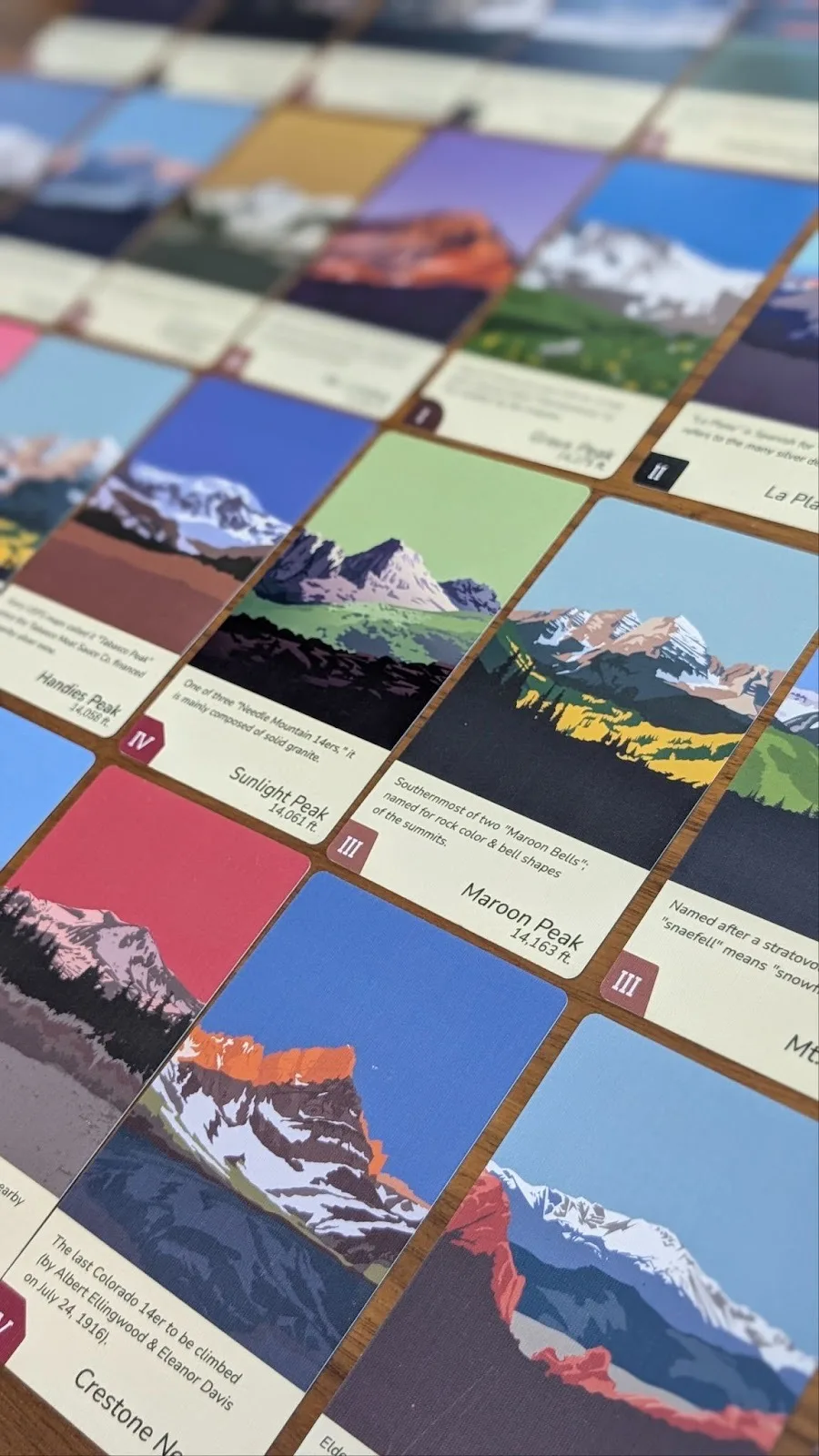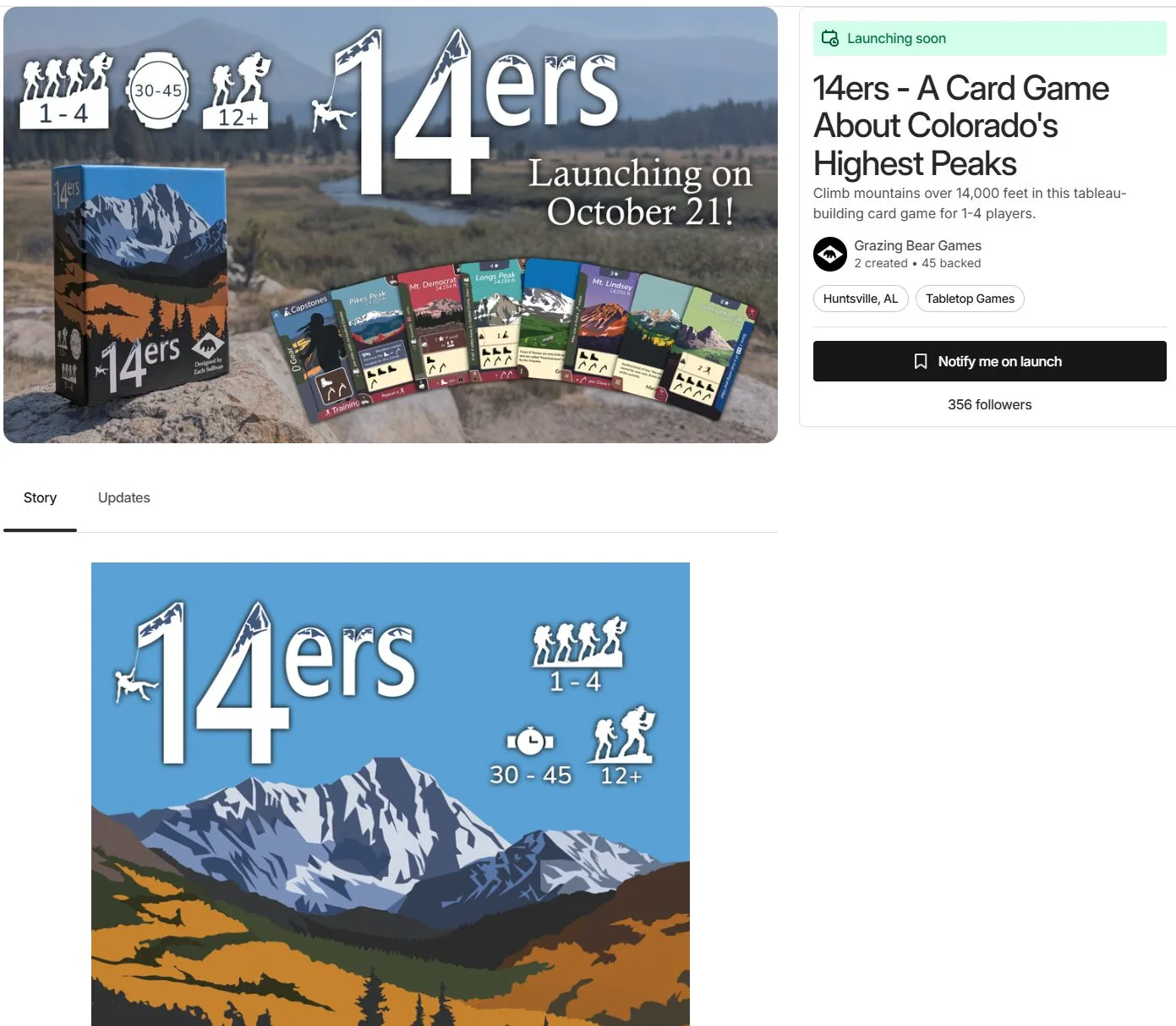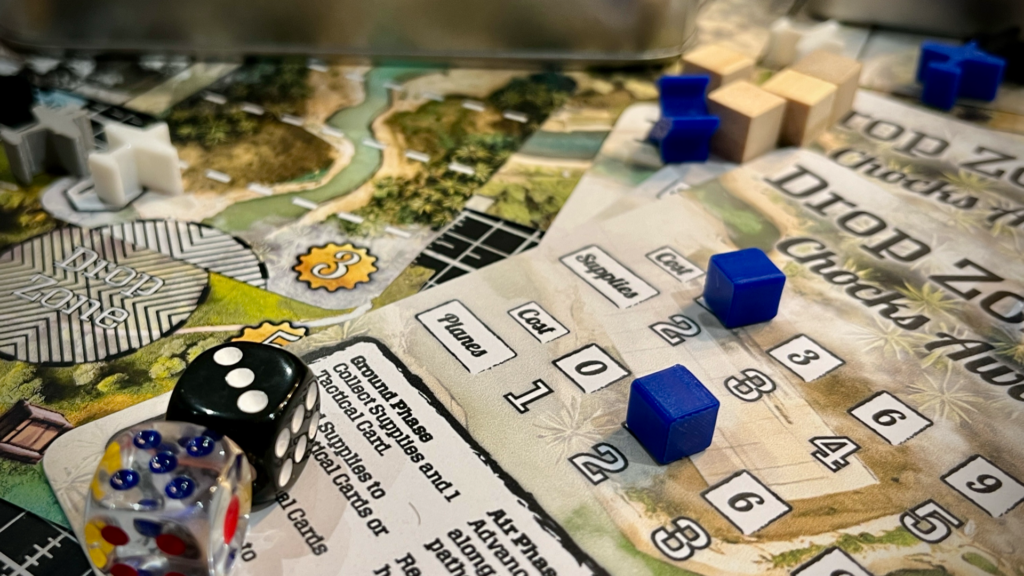Welcome back to the What If? Blog! This time I’m chatting with Zach from Grazing Bear Games, who’s about to launch his first physical game, 14ers, on Kickstarter. What caught my attention about Zach’s approach is how he frames game design as gift-giving. It’s not just marketing speak, it’s genuinely how he thinks about creating experiences for the people he loves and the wider gaming community.
We dive into how his wife’s passion for climbing Colorado’s 14,000-foot peaks became the theme for his game, what he learned from his first print and play Kickstarter campaign, and how building genuine community has shaped his approach to publishing. With a baby on the way and a Kickstarter launching in October, Zach’s got quite the winter ahead.
It’s a conversation about intentionality, community, and what it means to create games that add value to people’s lives. Enjoy.
Joe: Heya Grazing Bear Games, welcome to the What If? Blog. Can you tell us what brings you to the world of board games design?
Zach: Hi Joe, thanks for having me! I’ve been designing board games for fun since I was a kid, and more seriously since the pandemic. It’s been a great way to stretch the creative muscles, explore how and why I love board games myself, and to give back to the people around me.

Like many folks, running games of Dungeons and Dragons was a bridge for me towards designing and creating games. During the pandemic, I ran games for family and friends, and learned how to hone the craft by listening to a lot of Critical Role. There is one particular surprise in the show that their DM, Matthew Mercer, made specifically for his wife, Marisha (also a player), and it seemed to be genuinely moving for her. This helped me realise that making stories and experiences in games can be a gift to share with those we love and with the world.
This helped me realise that making stories and experiences in games can be a gift to share with those we love and with the world.
As I worked more on designing and testing board games, I learned one of my good friends was also designing games. We decided to take our game creation to the next level, so we dug into learning all we could, and started a local playtest group with other creators that meets monthly and constantly chats online. This community has been so helpful for accountability, encouragement, advice, and so much more!
Joe: Excellent back story. Before we explore what you’re working on, would you tell me a little more about the idea of games as gifts to be shared? It’s a lovely way of looking at it. How does it influence your designs and methods?
Zach: Gladly! There is both a general aspect in which any creation shared with the world is a gift to everyone who experiences it, and a personal aspect that may be specifically crafted and appreciated by a specific person or group. Let’s start with the general aspects.

Any experience that adds to others’ lives is a gift, and games can add a lot to our lives. Social games can build friendships and community, educational games can teach about history, science, and more, while narrative games can grow understanding and empathy toward others. Designing the game is an opportunity to think about what mechanics, feelings, and themes players will experience, while publishing the game is a chance to make those ideas as approachable as possible (reference cards, clear icons, etc.). Creating the game with every player in mind helps make a smoother experience that everyone can enjoy, and usually results in a more streamlined and better game.
Of course, there are also decisions made with specific players in mind, whether accessibility/inclusivity decisions to avoid a negative experience for certain groups, or easter eggs and other additions to add extra enjoyment for specific people. Michael Heron and others have done a great job covering accessibility and inclusivity in game design, so I won’t rehash his work but I will recommend it to others looking to learn more on that topic. I will say, though, that I have a lot of experience in adding things to games for specific people to enjoy: my first DnD session that I ran was for my family after my sister requested it, I wrote a 20-person murder mystery for my wife’s birthday party one year, and the theme of my next board game was chosen specifically for my wife as an activity and location that she particularly loved. Each of these had a theme, complexity level, time length, player count, story beats, character names, and other elements chosen specifically for that narrow target audience, although they could have worked for other groups also, just not as well.
Creating these experiences specifically for people I love not only fuelled the passion to make a project with excellence and see it to completion, but also gave a clear central vision to what the end result should look like because I knew what these people would like. So, not only is it more emotionally satisfying and feels good for my soul to make games with the idea of “giving” them to other people, it’s also a useful tool to help define the project and push yourself to actually finish it.
Creating these experiences specifically for people I love not only fuelled the passion to make a project with excellence and see it to completion, but also gave a clear central vision to what the end result should look like.
Joe: Thank you Zach. It’s lovely to hear this perspective articulated so well.
Tell me about your current project, 14ers, what’s the story?
Zach: 14ers is a tableau-building card game where you will climb different mountains in Colorado over 14,000 feet, and then gain abilities from those climbs by tucking them under your Hiker card to help you tackle more difficult ascents and gain more points. It’s a small-box game for 1-4 players that takes about 30-40 minutes to play, and I’d say it’s a medium-light or “gateway-plus” complexity game.

14ers started as a design exercise for myself after ProtoATL one year. I wanted to make an 18-card game just to learn from the process (18 cards is a common form factor chosen by designers since print sheets at game manufacturers usually make cards in multiples of 18 – 14ers quickly blossomed from there to be 60 cards instead!). I quickly came up with the core mechanism of tucking cards around the four different sides of one central card as a multi-use element, then just needed a theme to make the first prototype. I was driving with my wife at the time and decided that I would make the theme one of her favourite things, climbing 14ers in Colorado! She’s a very accomplished climber, having summited about 40 of Colorado’s peaks over 14,000 feet elevation and many other mountains, too. Of course, she was thrilled that I was making a game about one of her favourite things and loved consulting with me about terminology, fun facts, and more to flesh out the game, and she’s definitely gotten me hooked into the hobby now, as well. I’ve climbed 3 14ers myself so far, and hope to do more in the near future (we live several states away from Colorado, and that’s a big journey to do either with young kids or leaving them at home with the one parent).

We were insanely lucky that the art we found online for the very first prototype ended up being the illustrations we are using in the final game! There are a few artists who have made art series around Colorado’s 14ers, and I like them all, but we loved the colours and design choices in the illustrations that Hinterland Outdoors made. I got to meet the artist behind these pieces on a trip to Colorado last year, and he’s a very kind and humble guy who has personally climbed all 58 of Colorado’s 14ers and has been very easy to work with. His art really elevates the game and inspired the other layout and design choices that my graphic designer, Leslie Cheung, and I have made over the past months.
14ers will launch on Kickstarter on Tuesday, October 21st, and you can find the project page here!
Joe: That’s a lovely origin story, it’s so nice that you’re so connected to your game’s theme.
Your launch is not far away, so it would be great to get a little insight about your prep for that. Firstly, before we get into any nuts and bolts, how are you feeling?
Zach: Big question! Nervous, excited, stressed, happy, restless, impatient, grateful – all of these ring true for me. This isn’t the first Kickstarter campaign for me, I ran a successful campaign for 3 print and play games last autumn, so I have a little bit of an idea what I’m doing here. I’m so grateful for the many friends and other creators who have helped mentor me and teach me how to do things and what to expect, including many in the BoardGameProtoHype community. When I’m being rational, I feel almost as prepared as I can be, but of course I’m always a little anxious in the background, thinking “what else can I do?” and similar thoughts.

On top of launching the Kickstarter in October, my wife is also expecting a baby boy and due in December, so we’re doubly excited! I don’t know how common it is to have “baby break” built into your Kickstarter delivery timeline, but we are adding some extra margin to all of the timelines since we’re about to become parents again (we already have a daughter). It’s thrilling times all around for our family!
Joe: That’s one heck of a winter you’ve got coming up! Can we jump back in time briefly to your PnP campaign from last year? I wonder what you gained from that campaign, what you learned, and how it’s set you up for this coming campaign?
Zach: Sure! I ran a Kickstarter for 3 PnP games last autumn, all of which I designed and self-published. I got some great practice in several areas of game creation: ideation and design, playtesting, marketing, art direction, and more, without having to spend more than several hundred dollars for artwork and attending local conventions. It was really reassuring to see a lot of the conventional wisdom about Kickstarter campaigns play out exactly how my mentors said they would, and to see that I was starting to build an audience that liked me and my games enough to show up and pledge their hard-earned money on the first day of the campaign.
It was such a good learning experience to get tonnes of data and feedback on my skills as a game designer and publisher so I knew where and how to grow for this next upcoming game (and hopefully even more in the future!). I found out that I’m not the best at reaching massive quantities of people yet, but I am pretty good at high quality interactions: folks that I meet at conventions and other events who get to try out a game I’m working on have a pretty great chance of actually backing that game on Kickstarter later. I learned some basic skills in graphic design, photography, and more to create and edit some assets for social media and the Kickstarter page, but also recognised that some elements (project video, key infographics, game UI graphic design) were beyond my skills and needed the touch of a professional.
Finally, even though this is a much more complex endeavour with a physical product to manufacture, ship, and deliver this time, there are some things that I feel less stressed about than last time. I know that I can do this, and that people like my games and will pay money for them. I know that I have a loyal community supporting me and cheering me on, and conventions and similar events are way more fun now that I somewhat know the lay of the land and have more friends and contacts in the industry to see there. I know that, with the support and input from friends and fellow gamers, we can make something bigger and better than just I could ever make, and together we can bring cool games to life as a gift that everyone can enjoy.
Joe: Thanks Zach, this perspective is really useful. It sounds like community building has been something that you’ve enjoyed doing, whilst also being a key part of your success. How have you built that community? And what have you learned along the way?
Zach: Yes, growing a community has been vital, not just because they hopefully become customers, but more because they are vital for giving feedback, encouragement, and advice that improve both the games and me. Iterative loops of design and creation can have many solitary hours of work, but connecting with other people is a huge part of why many people play and make tabletop games in the first place, so integrating others into the creative process both keeps a steady “design compass” of what to build towards and is vital for my longevity and mental health.
While there are several groups and events online and in-person that have been instrumental to helping find community around me, I think one of the most important parts is approaching any interaction with a genuine desire to listen and give. When I’m reaching out to a retail store, content creator, or other potential partner, I try to think deeply about what I can offer them to add value to their lives and business, and how I can make any potential requests as easy and enjoyable as possible. I’m not that great at meeting hundreds and hundreds of people at a convention, but I do try to take the time to make two-way connections with those I do meet and play games alongside. I’ve been hugely blessed by many others in the tabletop gaming world, and I want to pass that forward and hopefully add a little bit more joy and kindness where I can.
Joe: That’s some really good advice. That genuine desire to listen and really building community rather than just seeking numbers of people is key to success.
OK, last question. How do we find you and your projects? And when is launch day?
Zach: I am active on Facebook and Instagram, and our website is www.grazingbeargames.com, or you can email info@grazingbeargames.com if you want to get in touch that way.
Kickstarter launch day is Tuesday, October 21st, at 10 AM Central Time (CST, UTC-6)! If you click the “notify me on launch” button here, you can get an email the moment I click the big “Launch” button!
Thank you so much, Joe, for inviting me and for your thoughtful questions!
What stands out most about Zach’s approach is how intentional everything is. The game theme isn’t arbitrary, it’s a love letter to his wife’s passion. The community building isn’t transactional, it’s about genuine connections and giving value. Even his first PnP Kickstarter wasn’t just about getting games funded, it was a deliberate learning experience to prepare for this next step.
There’s something refreshing about someone who sees game design as gift-giving rather than product development. It shifts the entire focus from “what can I sell” to “what can I create that adds value to people’s lives”. That philosophy shows up in everything from his accessibility considerations to his approach to conventions. With 14ers launching soon and a baby arriving in December, Zach’s living proof that meaningful community and thoughtful design go hand in hand. If you’re wondering whether genuine connection beats aggressive marketing, his journey suggests it absolutely does.


